Mary Barbour
Mary Barbour (née Rough; 20 February 1875[1] – 2 April 1958) was a Scottish political activist, local councillor, bailie and magistrate. Barbour was closely associated with the Red Clydeside movement in the early 20th century and especially for her role as the main organiser of the women of Govan who took part in the rent strikes of 1915.[2]
Mary Barbour | |
|---|---|
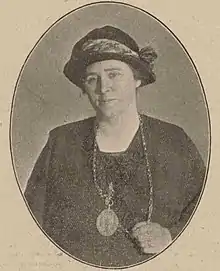 | |
| Born | Mary Rough 20 February 1875 Kilbarchan, Scotland |
| Died | 2 April 1958 (aged 83) Southern General Hospital, Glasgow, Scotland |
| Nationality | Scottish |
| Occupation(s) | Political activist, local councillor, bailie, magistrate |
| Known for | Glasgow rent strikes, Women's Peace Crusade |
| Spouse | David Barbour (m. 1896–1957) |
| Children | David (1897–1897) James William |
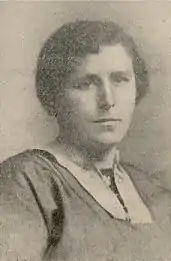
Life
Barbour was born on 20 February 1875 at 37 New Street, Kilbarchan to Jean (Gavin) and James Rough, a handloom carpet weaver.[3] She was the third of seven children. Barbour attended school until she was fourteen years old. In 1887, the family moved to the village of Elderslie and Barbour worked as a thread twister, eventually becoming a carpet printer. On 28 August 1896, Mary Rough married an engineer, David Barbour (2 May 1873 – 13 November 1957), at Wallace Place, Elderslie.[4][5][6] By the 1901 census, the couple had settled in Govan at 5 Macleod Street, where they lived with their son, James. Their son David died in infancy in 1897.[7] By the 1911 census, the family, including another son, William, had moved to 43 Ure Street (now Uist Street).[8]
In 1933, Barbour moved to a council house at 34 Cromdale Street in Drumoyne, Glasgow, where she lived until her death.[9][10] One year after she was widowed, Barbour died at age 83 in the Southern General Hospital, Glasgow.[10] Her funeral was held at Craigton Crematorium in Cardonald, near Govan.
Political activism
Barbour first became politically active as a member of the Kinning Park Co-operative Guild. Barbour's political activism began in earnest in leading the South Govan Women's Housing Association during the Glasgow rent strikes of 1915, when she actively organised tenant committees and eviction resistance. The protestors became known as "Mrs Barbour's Army", and included Agnes Dollan, Helen Crawfurd, Mary Burns Laird, and Mary Jeff.[11]
Women's Peace Crusade
Barbour was a founder of the Women's Peace Crusade (WPC) at the "Great Women's Peace Conference" in June 1916, with Helen Crawfurd and Agnes Dollan.[12] These women also worked with Agnes Harben and others across Britain.[13]
The WPC campaigned throughout June and July 1916 for a negotiated settlement to World War I. Barbour and the others organised this predominately through open air meetings in Glasgow, Clydeside and Edinburgh. The possibility of a negotiated peace settlement became less likely with the formation of a new coalition government in December 1916, led by Lloyd George.[14]
Both the Russian Revolution and the Irish Easter Rising provided a catalyst for renewed peace activism in Scotland, including the work of the WPC.[15][16] The 1917 annual May Day celebration in Glasgow Green brought together 70,000 people. Women peace activists, including Barbour, Dollan and Mary Burns Laird, were prominent among the speakers. This type of activity inspired the re-launch of the Women's Peace Crusade in July 1917, on Glasgow Green with 10,000 people taking part.[17] Other branches of the WPC were then established throughout Scotland, England and South Wales.[18] Their campaign continued until the end of World War I.[19]
Political career
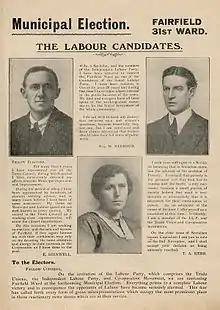
In 1920, Barbour stood as the Labour candidate for Fairfield ward in Govan, and was elected to Glasgow Town Council, becoming the one of the city's first woman councillors. While Barbour has often been credited as being 'the first Labour woman councillor in Glasgow',[12][20] this is not the case. Barbour was one[21] of a pioneering group of five women who were elected in 1920 which included Eleanor Stewart (Maryhill) as the other Labour woman councillor, and Jessica Baird-Smith, Mary Bell and Mary Anderson Snodgrass all respectively elected as Moderate councillors.[22][23][24] It would appear that the misconception about Barbour being the "first Labour woman councillor" originated in Patrick Dollan's book about the Kinning Park Co-operative Society, published in 1923.[24] While standing for election, Barbour stated that "the advent of a woman candidate was seen by some men and women as outrageous", but contended that women councillors were needed to tackle issues that affected women and children.[25]
From 1924–27 Barbour served as one of Glasgow Corporation's first woman baillies, alongside Mary Bell.[26] Barbour was appointed as one of the first woman magistrates in Glasgow.[27] Barbour became a Justice of the Peace for the City of Glasgow in January 1928.[28]
Role in provision of health and welfare services
From 1925, Barbour was Chair of the Glasgow Women's Welfare and Advisory Clinic,[2] and had worked with the Glasgow Corporation's specialist in child and female healthcare, Dr Nora Wattie, to establish the clinic, manned by female nurses and doctors.[12] Barbour gave a speech at the opening of the clinic in August 1926, in a storefront at 51 Govan Road, which was the first site offering advice on birth control in Scotland.[29] The clinic subsequently moved to 123 Montrose Street, Glasgow during 1932.[30]
In November 1926, Barbour attended the opening of the West Govan Child Welfare Clinic.[31] This building, at 20 Arklet Street, Govan, remains in use by NHS Greater Glasgow and Clyde as Elderpark Clinic.[32]
During her tenure as a councillor and Bailie,[33] Barbour worked relentlessly on behalf of the working class people of her constituency, serving on numerous committees covering the provision of health and welfare services, and even after her retirement in 1931, Barbour remained involved in this area.
Influence and recognition
Mary Barbour in popular culture
Mary Barbour is name-checked in Scottish Women's Power Anthem 'Girl (Daughter of Scotland)' by Sharon Martin.
Chris Hannan's play Elizabeth Gordon Quinn was first performed at the Traverse Theatre, Edinburgh on 29 June 1985.[34] It was directed by Steven Unwin. The play is set during the rent strike in Glasgow, 1915. Although Barbour does not feature as a character, the play reproduces a famous Barbour incident from the rent-strike. The most important thing in the Quinn household is the piano.[34] In Part One Scene Two, the piano is sequestrated by sheriff officers in lieu of owed rent. The Quinns, at this point, are not rent-strikers but are instead simply unable to pay their rent because of their poverty. In Part One, Scene Four William Quinn (Elizabeth's husband) narrates how he, aided by fifty women rent-strikers, and with the assistance of shipyard workers simply walked into the factor's office and asked for it to be returned.
The factor was afraid of us
— William Quinn, Part 1 Scene 4
Helen Crawfurd in her unpublished memoir recounts how during the rent-strike factors would try to collect the rental increases by resorting to the blackmail of social humiliation. The ploy was to dupe individual household tenants into believing that everyone else in the close had paid up. Upon one of these occasions Barbour drafted in men from Govan's shipyards, led them to the factor's office and demanded the amount of the increase be returned. 'Faced with thousands of black-faced workers the factor handed over the money' Crawfurd recalls.[35]
The song Mrs Barbour's Army by Alistair Hulett is about Mary Barbour's organisation of the 1915 rent strike.[36] A song was also written about Mary Barbour by Glasgow singer/songwriter Lainey Dempsey.
Barbour was the subject of one of the Not Forgotten series of documentaries on Channel Four in 2007.[37] In 2012 the BBC Radio 4 programme Woman's Hour ran a profile about Mary Barbour following the writing of a poem about her by Christine Finn for an exhibition at the National Museum of Scotland.[38] The poem was called Mary Barbour's Rattle and can be viewed on the Museum's website.[39]
Mrs Barbour's Daughters is a play by A.J. Taudevin.[40] It was first produced in October 2014 in Oran Mor, Glasgow in association with the Traverse Theatre. The play is set in a tenement flat in Govan where the lead character's memories come back to life in a series of flashbacks. The play is divided into eleven sections, and although Mrs Barbour is a recurring presence in the play, she only appears as a character in the penultimate section where she makes a speech set during the period of the rent strike. A review in The List concluded that "Mrs Barbour's Daughters is a concise and moving sketch of the feminist tradition and makes its point using sweet harmony, not rabble rousing."[41]
The original cast included; Mary-Anna Hepburn played Grace, Gail Watson played Joan and Libby McArthur Mrs Barbour. The director was Emma Callander assisted by Andy McNamee.
Mary Barbour was also the inspiration behind the character of Agnes Calder in J David Simons' novel The Liberation of Celia Kahn (Five Leaves 2011, re-printed Saraband 2014). Also featured in the novel are the Glasgow women's involvement in the Rent Strikes and the events leading up to the foundation of the first birth control clinic in Govan, Glasgow.[42]
Special tribute in "The Govan Press" newspaper
In honour of Mary Barbour's 74th birthday, the local newspaper devoted much of its front page to a birthday celebration held in her honour in the Engineers' Hall, Govan. The article recounted her activism, with many of her former associates in attendance. The "bumper birthday party" as the newspaper styled it, was organised by the Govan Women's Housing Association, of which Barbour was the founder and Honorary President. Bailie Jack Davis from the City Council not only highlighted Barbour's personal achievements, but told his audience how much she had inspired other women by her leadership.[43]
Statue
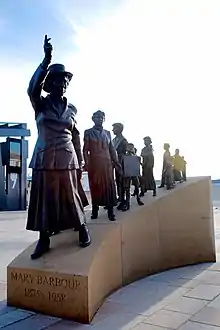
In 2011, Glasgow Women's Library commissioned 21 artworks as part of their 21st anniversary celebrations.[44] Glasgow-based artist Sharon Thomas chose to depict a hypothetical monument to Barbour in Govan.[45] The work generated interest in a real statue of Barbour, which in 2013 led to the creation of the Remember Mary Barbour Association (RMBA), who campaigned for a statue. The campaign garnered support from Glasgow City Council,[46][47][48] Nicola Sturgeon,[49] the Scottish Parliament[50] and Sir Alex Ferguson.[51][52]
In September 2015 five sculptors were shortlisted[53] to produce a maquette to convey their vision of a fitting statue. Public showings of the set of five maquettes were scheduled to take place from November 2015 through February 2016, at various locations commencing at the Pearce Institute in Govan. Sculptor Andrew Brown was selected to sculpt the statue in February 2016.[54]
Although having secured about £56,000 through public donations, approximately half of the funding needed to build the statue, the RMBA's application to Creative Scotland was rejected in November 2015 based on an apparent lack of community engagement.[55] In order to meet the shortfall and raise the money to complete the project, the RMBA planned several events including a gala concert to be held in the Old Fruitmarket in Glasgow.[56]
The statue was completed in 2017 and unveiled in March 2018.[57]
 Etching of hypothetical Mary Barbour monument in Govan, Glasgow, by artist Sharon Thomas
Etching of hypothetical Mary Barbour monument in Govan, Glasgow, by artist Sharon Thomas Crowds gather for the unveiling of the statue of Mary Barbour at Govan Cross, Glasgow.
Crowds gather for the unveiling of the statue of Mary Barbour at Govan Cross, Glasgow. Statue to commemorate Mary Barbour, Govan Cross, Glasgow.View from the side.
Statue to commemorate Mary Barbour, Govan Cross, Glasgow.View from the side.
The Kilbarchan Cairn
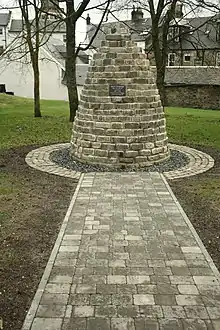
In May 2015, Renfrewshire Council agreed to fund a commemorative cairn in Barbour's home village of Kilbarchan. The Council estimated the cost of the cairn to be £6,000 which was funded from the Renfrewshire Citizens Fund following a recommendation from the council’s Johnstone and the Villages Local Area Committee.[58][59] The cairn was installed in New St, where Barbour was born, and was unveiled on 21 November 2015 by the Provost of Renfrewshire, Anne Hall, in the presence of Barbour's descendants.[60]
Renfrewshire Council also agreed[61] to establish and fund a Mary Barbour Prize to be awarded annually to a school pupil at Kilbarchan Primary School.[58]
 New Street, Kilbarchan, showing location of Mary Barbour Cairn
New Street, Kilbarchan, showing location of Mary Barbour Cairn Plaque on Mary Barbour Cairn - Champion of the People and Social Reformer
Plaque on Mary Barbour Cairn - Champion of the People and Social Reformer
Clutha Bar Mural
Mary Barbour is one of two women included in the Clutha Bar mural, and her image is based on the photograph of her in Bailie's robes, c.1924. The Clutha Bar was the site of the Glasgow helicopter crash on 29 November 2013. The mural, coordinated by Art Pistol, features work by a number of artists including Bob McNamara, who is also known as Rogue One, and Danny McDermott, known as EJEK.[62] The mural pays homage to the history of the area, and shows a variety of people who have visited this location.[63]
 West side of the Clutha Bar Mural, Glasgow
West side of the Clutha Bar Mural, Glasgow Mary Barbour c.1924 in Baillie's robes
Mary Barbour c.1924 in Baillie's robes
Blue Plaque in Linthouse

In November 2015, Linthouse Housing Association installed a blue plaque at 10 Hutton Drive, Linthouse, Glasgow to commemorate Mary Barbour and her actions, and those of many other women, during the 1915 Glasgow Rent Strikes.[64][65] The location references a widely known image from the time of a gathering of people outside the tenement property taking part in a rent strike action.
The text of the plaque describes Barbour as a "Social Reformer, Rent Strike Leader, Women's Peace Crusader and Pioneering Woman Councillor", and incorporates a quote from William Gallacher's book 'Revolt on the Clyde'.
 Glasgow Rent Strikes Blue Plaque and Mary Barbour banner
Glasgow Rent Strikes Blue Plaque and Mary Barbour banner
References
- "SR Birth Search for Mary Rough (Statutory Births 568/00 0059)". Scotland's People.
- Audrey Canning, ‘Barbour , Mary (1875–1958)’, Oxford Dictionary of National Biography, Oxford University Press, 2004; online edn, May 2006 accessed 14 Feb 2014
- "SR Birth Mary Rough (Statutory Births 568/ 59)". Scotland's People. Archived from the original on 3 December 2012.
- "SR Marriage David Barbour Mary Rough (Statutory Marriages 559/03 0076)". Scotland's People. Archived from the original on 3 December 2012.
- "SR Birth David Barbour (Statutory Births 559/03 0133)". Scotland's People. Archived from the original on 3 December 2012.
- "SR Death David Barbour (Statutory Deaths 644/10 1248)". Scotland's People. Archived from the original on 3 December 2012.
- 1901 Census (646/2 69/ 38) Retrieved 2018-03-21.
- 1911 Census (646/2 47/ 17). Retrieved 7 March 2018.
- Glasgow Electoral Registers, 1857-1962.
- "SR Death Mary Barbour (Statutory Deaths 644/10 0448)". Scotland's People.
- "Mary Barbour 1875-1958". acumfaegovan. Retrieved 13 February 2013.
- The Biographical Dictionary of Scottish Women. Edinburgh: Edinburgh University Press. 2007. p. 29. ISBN 9780748632930.
- "Women's International League". Spartacus Educational. Retrieved 21 January 2021.
- Duncan, Robert (2015). Objectors and Resisters: opposition to conscription and war in Scotland 1914 - 18. Common Print. pp. 135, 136. ISBN 9780993096518.
- Taudevin, A J (2015). Mrs Barbour's Daughters. Oberon Modern Plays. p. 67. ISBN 9781783199846.
- Duncan, Robert (2015). Objectors and Resisters: opposition to conscription and war in Scotland 1914 - 18. Common Print. pp. 136, 137. ISBN 9780993096518.
- Duncan, Robert (2015). Objectors and Resisters: opposition to conscription and war in Scotland 1914 - 18. Common Print. pp. 137, 138. ISBN 9780993096518.
- "WOMEN'S PEACE CRUSADE". menwhosaidno.org. Retrieved 4 July 2020.
- Smyth, J J (2000). Labour in Glasgow 1896 - 1936: socialism, suffrage, sectarianism. Tuckwell Press. p. 177. ISBN 186232137X.
- BBC (9 March 2012). "International Women's Day celebrates the life of Mary Barbour". BBC News. BBC. Retrieved 11 January 2016.
- "How The Results Were Taken". The Govan Press. 5 November 1920.
- "The Municipal Elections". Common Cause. 5 November 1920.
- "Women Municipal Candidates". The Vote. 5 November 1920.
- Burness, Catriona (2015). Gall, Gregor; Phillips, Jim (eds.). "Remember Mary Barbour". Scottish Labour History. The Scottish Labour History Society. 50: 90. ISSN 1472-6041.
- Baxter, Kenneth (November 2013). "'The Advent of a Woman Candidate Was Seen . . . As Outrageous': Women, Party Politics and Elections in Interwar Scotland and England". Journal of Scottish Historical Studies. 33 (2): 268. doi:10.3366/jshs.2013.0079. Retrieved 15 May 2020.
- Lenton, Lilian (12 December 1924). "Bailie Barbour of Glasgow". The Vote.
- "Mary Barbour : Radical Glasgow : Glasgow Caledonian University". Archived from the original on 15 April 2012. Retrieved 19 March 2012.
- "New JPs for City of Glasgow". The Scotsman. 3 January 1928.
- "Birth Control Local Clinic Opens for Married Women". The Govan Press. 13 August 1926.
- Kelly's Directory of Glasgow. Kelly’s Directories Ltd. 1933.
- "New Clinic for West Govan". The Govan Press. 26 November 1926.
- "NHSGCC : Elderpark Clinic". Retrieved 22 March 2018.
- Brockelhurst, Steven. "World War One: The woman who took on the slum landlords". BBC. Retrieved 13 August 2022.
- Hannan, Chris (1990). Cameron, Alasdair (ed.). Elizabeth Gordon Quinn. London: Nick Hern Books. ISBN 1-85459-017-0.
- Craig, Maggie (2011). "Mrs Barbour's Army: The Rent Strike of 1915". When The Clyde Ran Red. Edinburgh: Mainstream. pp. 111–112. ISBN 978-1-84596-735-2.
- Nick Martin, "Interview with Alistair Hulett 1 April 2002"
- Women on Red Clydeside
- "Mary Barbour and the Glasgow Rent Strikes". Woman's Hour. 29 November 2011. Event occurs at 10:00. BBC. BBC Radio Four.
- Finn, Christine. "Govan rent strike rattle". National Museum of Scotland. Archived from the original on 9 February 2014. Retrieved 14 February 2014.
- Taudevin, A.J. (2015). Mrs Barbour's Daughters (A Glasgow Rent Strikes Centenary ed.). London: Oberon Books. p. 1353. ISBN 978-1-78319-984-6.
- Irvine, Lorna (10 October 2014). "A Play, a Pie and a Pint: Mrs Barbour's Daughters". The List. Retrieved 9 January 2016.
- "The Liberation of Celia Kahn". Historical Novel Society. Retrieved 28 June 2021.
- "Seventy-Four today! Housing Association honours founder". The Govan Press. 4 March 1949. p. 1.
- "21 Revolutions". Glasgow Women's Library. Retrieved 6 January 2018.
- McMeekin, Elizabeth (9 March 2012). "New artwork to celebrate the life of Govan heroine". The Herald. Retrieved 6 January 2018.
- Glasgow Young Scot, 20 Trongate. "Lord Provost to launch Remember Mary Barbour Fund". Retrieved 10 January 2016.
- Glasgow Young Scot, 20 Trongate. "Statue salutes Glasgow's first female councillor". Retrieved 10 January 2016.
- "Statue to Mary Barbour gets go-ahead". Evening Times. Retrieved 9 January 2016.
- "First Minister hails tribute to forgotten leader of tenants' revolt". dailyrecord. Retrieved 9 January 2016.
- Report, Official. "Official Report". Retrieved 9 January 2016.
- Glasgow Young Scot, 20 Trongate. "Sir Alex Ferguson donates to Remember Mary Barbour Fund". Retrieved 10 January 2016.
- "Sir Alex Ferguson supports fund for Mary Barbour statue". BBC News. Retrieved 9 January 2016.
- "MARY BARBOUR STATUE UPDATE". Remember Mary Barbour. Retrieved 9 January 2016.
- Rodger, Hannah (22 February 2016). "Sculptor Andrew Brown selected as winner of contest to celebrate Glasgow rent strikes heroine". The Sunday Herald. Retrieved 6 January 2018.
- Tufft, Ben (29 November 2015). "Anger as Creative Scotland snubs statue to feminist icon Mary Barbour". The Herald. Herald & Times Group. Retrieved 10 January 2016.
- Wilson, Caroline (27 December 2015). "Glasgow to host major gala concert to celebrate the life of social reformer Mary Barbour". Evening Times. Herald & Times Group. Retrieved 10 January 2016.
- "Statue to social pioneer Mary Barbour unveiled in Glasgow". STV News. 8 March 2018. Retrieved 8 March 2018.
- "Cash pledged towards Mary Barbour cairn". The Gazette. 30 August 2015. Retrieved 1 August 2021.
- "Kilbarchan to unveil Mary Barbour cairn". The Gazette. Retrieved 10 January 2016.
- "Pioneering social activist Mary Barbour honoured in her home village". Paisley Scotland. Retrieved 9 January 2016.
- Council, Renfrewshire (21 May 2015). "Mary Barbour". Renfrewshire Council. Retrieved 10 January 2016.
- Weldon, Victoria (23 May 2015). "Famous faces immortalised on the walls of the Clutha". The Herald. Retrieved 10 January 2016.
- "City Centre Mural Trail". Glasgow City Council. Retrieved 10 January 2016.
- Wilson, Caroline (14 November 2015). "Tribute to fearless Mary Barbour, the rent strike heroine". Evening Times. Retrieved 1 November 2019.
- "Linthouse honours housing pioneer". Scottish Housing News. 17 November 2015. Retrieved 1 November 2019.